 Is social media not working for you?
Is social media not working for you?
Are you struggling to form a social media connection with your audience?
Have you found that the recommended “getting started” tips and tricks for social campaigns just haven't resonated with your followers?
The truth is, while there are plenty of audiences that respond well to social media marketing attempts, there are others that don't for a number of different reasons.
In this article you'll find out how to recognize the variables that could result in an audience-marketer mismatch and how to work around them.
Why Your Social Media is Not Working?
If you feel like you've tried everything to connect with your audience, but it's just not working, you're probably looking to social media experts for advice. Maybe you've followed that advice, but your audience still isn't responding. What's going on?

Well, it may not be the advice or implementation that's your problem. The problem may be your choice of social platform, your industry's expectations or even your audience's comfort level with social media.
To find out, I suggest looking closely at age and demographic matches, the size of your audience, industry standards and your audience's interest in engaging online. In this article I'll discuss each of these and how they can affect your social engagement, then offer advice on how you can work on those issues.
Know Whom You're Talking To
A recent Pew Internet study revealed that 73% of online adults use a social networking site of some kind, but only 42% use multiple social media sites.
The following chart demonstrates how these percentages break down.
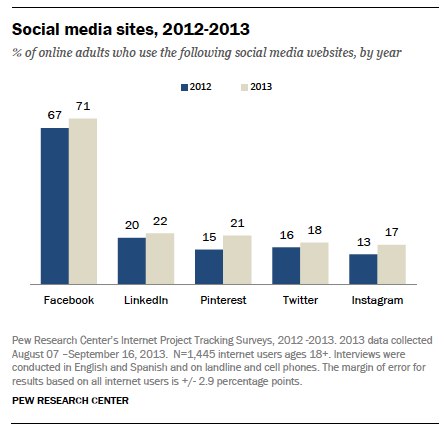
Considering the data from the study, let's talk about how it can apply to you.
Imagine your audience is primarily made up of middle-aged women who, according to the study, are four times as likely as men to be Pinterest users.
If you're focusing your social marketing efforts on Facebook because of its high adoption rate but not seeing engagement, it could be because your primary audience is spending its time on Pinterest.
Get World-Class Marketing Training — All Year Long!
Are you facing doubt, uncertainty, or overwhelm? The Social Media Marketing Society can help.
Each month, you’ll receive training from trusted marketing experts, covering everything from AI to organic social marketing. When you join, you’ll also get immediate access to:
- A library of 100+ marketing trainings
- A community of like-minded marketers
- Monthly online community meetups
- Relevant news and trends updates
It may be time to reevaluate who your target customer is. When you know your audience and their social platform of choice, it's much easier to engage them.
Understand That Size May Be a Factor
Another reason you may not be making a strong connection with your customers could be related to the size of your audience on a given social channel.
This infographic from Mediabistro shows interests across Pinterest, Facebook and Twitter.
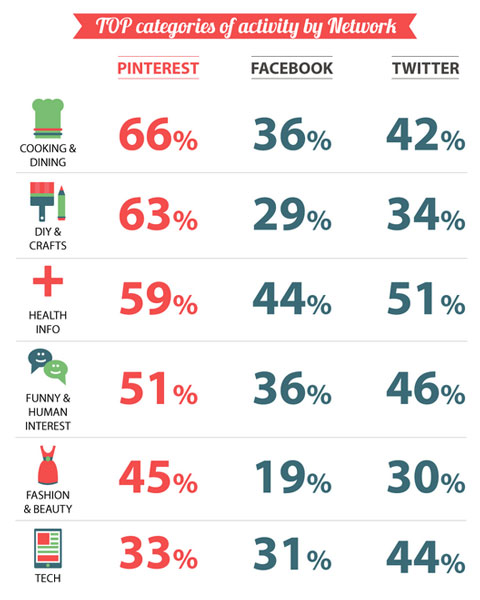
If you're selling a high-dollar product, you're more likely to have a very small and specific audience. As a result, sending out broad messages via social media may not be the best way to connect with them.
Consider Your Industry's Culture
In some cases, a company may not see high engagement simply because of industry culture. Perhaps the overall industry is behind the times technologically. That could be because either their customers or the industry as a whole aren't familiar with social media or comfortable using it.
If you're in a very personalized industry (e.g., the funeral profession), getting your clients to engage on social sites may be a challenge simply because they don't think to look for you online unless it's to look up your phone number. In those cases, it's unlikely they'll reach out via social media.
Not all businesses exist in industries that naturally lend themselves to online engagement.

As an example, take the partnership my company recently had with Self Storage Finders. They’re a service that helps consumers identify and evaluate different storage providers in their area.
While this type of service is valuable to the customers who use it, those clients don't necessarily think about discussing their storage experiences on social sites.
While these variables and their impact on engagement are frustrating, it's not impossible to market to difficult audiences.
The following three tips should help you adapt social media marketing recommendations and best practices to suit the needs of your specific (if challenging) audience.

Discover Proven Marketing Strategies and Tips
Want to go even deeper with your marketing? Check out the Social Media Marketing Podcast! Publishing weekly since 2012, the Social Media Marketing Podcast helps you navigate the constantly changing marketing jungle, with expert interviews from marketing pros.
But don’t let the name fool you. This show is about a lot more than just social media marketing. With over 600 episodes and millions of downloads each year, this show has been a trusted source for marketers for well over a decade.
Keep in mind, though, that your social media marketing strategy may necessarily follow a different path than it would if your audience were more amenable to social conversations.
Know Where To Be
Conventional social wisdom says that all businesses need to maintain a Facebook and Twitter profile. I have a different point of view. I believe that creating social identities and then essentially abandoning them because of lack of engagement does more harm than good to a business.
What did you discover when you reevaluated your audience? You may have discovered that the most active community engagement portals in your industry aren't social sites at all—they're forums and “old-school” message boards.
If that's the case, you have to set conventional wisdom aside and focus your efforts on the arenas where they'll be noticed in the first place!
See What Sticks
You've looked at your audience, you know where they are and you've set up shop there. Now let's suppose you're getting ready to start a social promotion for an audience you're pretty sure is going to be difficult to engage.
There are plenty of different templates out there for possible social posts. I recommend trying as many as you can. I call this the spaghetti-flinging approach because it's as if you're throwing spaghetti at the wall to see what sticks.
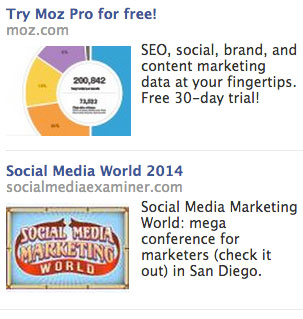
If you've chosen to focus your efforts on Facebook, try posting text-based status updates, images, links, polls, paid ads and more. Post at different times of day and on different days of the week.
While it's nice to see engagement at this stage, the true goal of early social posting to difficult audiences should be to gather data.
Remember, you can't trust the industry pundits to tell you what will work best for every audience, so use your own metrics and gather your own data.
Look For Your Loudest Fans
As you post more updates, you'll likely find the members of your community who are more highly engaged than others. Make sure these people aren't your employees, close friends or relatives!
When you've found your most active fans, pay attention to the exact types of content they're engaging with. Use this data to refine your posting techniques to include content that's likely to appeal to these users.
Take a look at the following screenshot from the Self Storage Finders Facebook page before we started working with them. This particular update didn't resonate with audience members, so it had no engagement whatsoever.
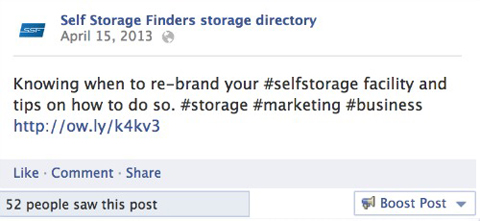
When we started working with them, we began experimenting with different types of posts and content and we noticed that fans reacted well to cartoon images.
Below you can see how catering to fans' favorite type of post results in more likes, all because we were willing to experiment and base future posts on actual audience data.
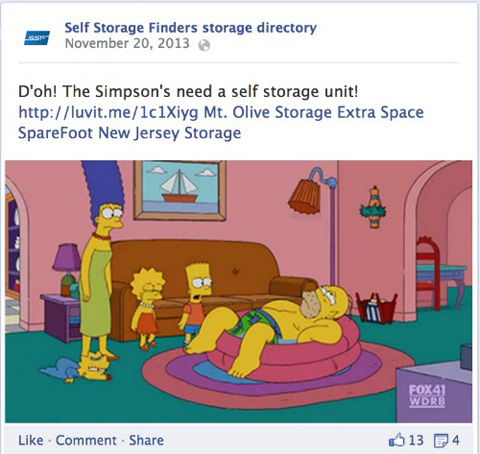
Know When to Cut Your Losses
Unfortunately, there are audiences out there that simply don't respond to social media marketing. But that doesn't mean you should throw in the towel.
Take another look at the data you gathered from your audience analysis and post experiments. Compare it to your established metrics and install analytics tools that will provide additional data to help you figure out whether your social marketing is working.
Let's say you determine that including man-hours, image subscriptions and other investments, you put roughly $500 per month into your social campaigns. What does your data tell you? Are your social channels sending you visitors that result in more than $500 per month in sales?
That example is a simplification of social marketing's value, of course. It's true that social media can lead to extensive brand awareness that may indirectly lead to sales. But if you consistently see that your profits are falling short of your investments, it may be time to either refocus your strategy or pull the plug on your social efforts entirely.
The Bottom Line
If you're not getting traction with your social media marketing, take a break from researching broad advice that promises a quick fix. Reevaluate your efforts: meet your customers where they are, consider the size of your audience and set your expectations accordingly.
Not every business will have success with social media marketing no matter how hard they try, but it's worth the time to experiment with different tactics and gather data before calling it quits.
What do you think? Have you ever found yourself marketing to a difficult audience? If so, what social media marketing tips do you have to add for those in this situation? Leave your experience and advice in the comments.
Images from iStockPhoto.
Attention Agency Owners, Brand Marketers, and Consultants

Introducing the Marketing Agency Show–our newest podcast designed to explore the struggles of agency marketers.
Join show host and agency owner, Brooke Sellas, as she interviews agency marketers and digs deep into their biggest challenges. Explore topics like navigating rough economic times, leveraging AI, service diversification, client acquisition, and much more.
Just pull up your favorite podcast app, search for Marketing Agency Show and start listening. Or click the button below for more information.

